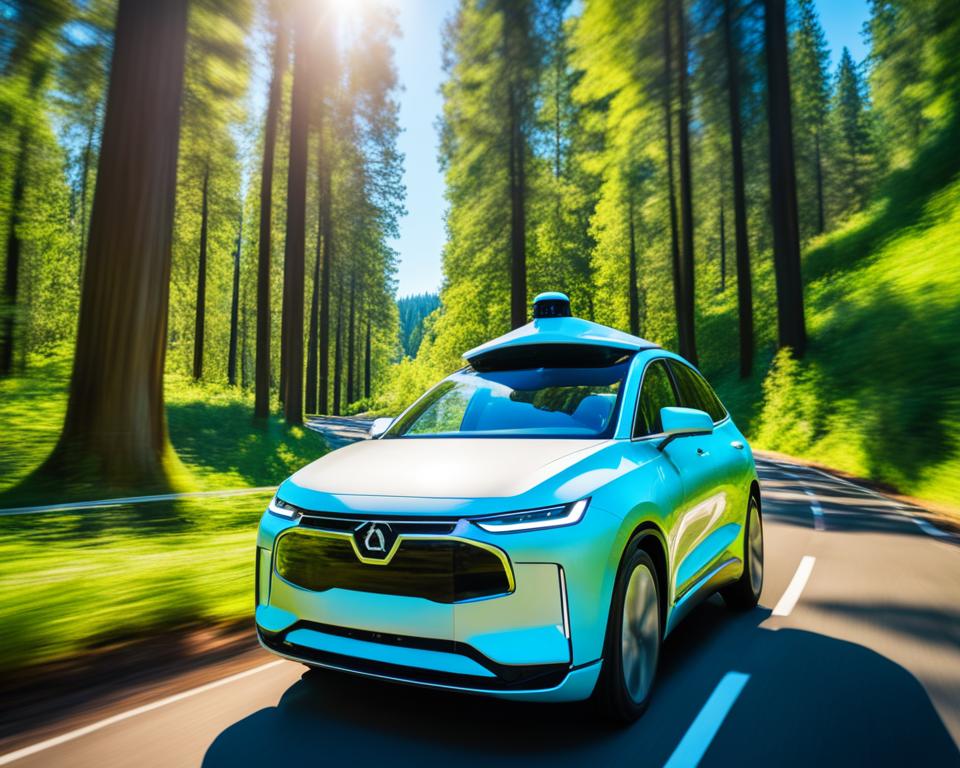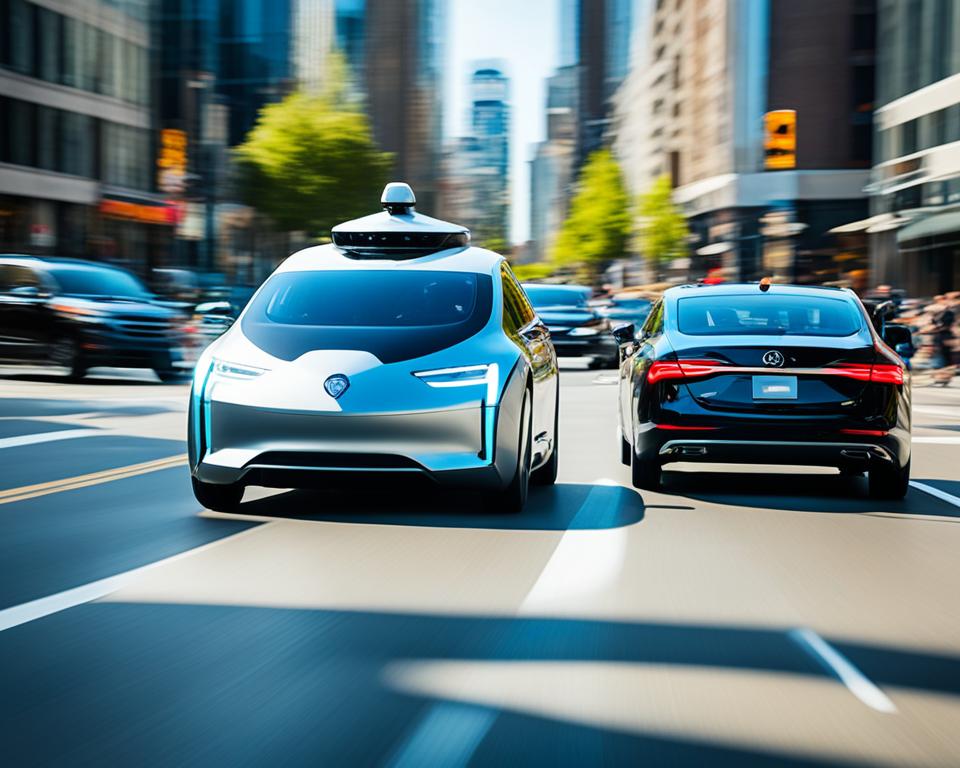The auto pilot car is changing how we see driving. This new tech, known as autonomous or self-driving vehicles, is making roads safer and more convenient. It uses advanced sensors, AI, and automation to lead the way in smart transportation.
These cars are making driving easier and safer. They’re changing the way we move around. With their advanced technology, they’re setting new standards for driving.
Read interesting things at : kamilyle
Key Takeaways
- Auto pilot cars, or autonomous vehicles, are transforming the transportation industry with their advanced sensor systems and AI-powered navigation.
- These self-driving cars aim to enhance safety, convenience, and accessibility on the roads by automating the driving experience.
- Vehicle automation systems and intelligent transportation technologies are at the heart of this emerging driverless revolution.
- Sensor-based driving assistance and advanced driver-assistance systems (ADAS) are essential components of autonomous car technology.
- The future of personal transportation is being redefined by the rise of auto pilot cars and their robotic driving capabilities.
Unveiling the Era of Self-Driving Vehicles
The era of self-driving cars is here, bringing a new way to travel. These cars use sensors, cameras, and smart software to drive on their own. They don’t need a human to tell them what to do.
Companies big and small are putting a lot of effort into making these cars. They want to make a future where cars can drive by themselves. This will change how we travel and get around.
Getting to self-driving cars took a lot of work. It involved big steps in technology like sensors, artificial intelligence, and computer vision. Now, we’re moving from cars that help drive to ones that can drive on their own.
| Key Milestones in Autonomous Car Development | Timeframe |
|---|---|
| Adaptive Cruise Control and Lane Keeping Assist introduced | Early 2000s |
| Google’s Self-Driving Car Project launched | 2009 |
| Tesla Autopilot feature unveiled | 2014 |
| Waymo (formerly Google’s self-driving car) begins public testing | 2017 |
| Uber and Lyft introduce self-driving ride-hailing services | 2018-2020 |
As self-driving car tech gets better, the future of travel is changing. We’re entering an exciting time with these cars. The era of self-driving vehicles is here, and it’s going to be amazing.
Understanding Autonomous Car Technology
Autonomous car technology is all about sensor-based driving and AI-powered navigation. These cars have sensors like radar, lidar, and cameras. They watch the world around them, spotting obstacles, people, and other cars. Advanced driver-assistance systems (ADAS) use this info to help the car make quick decisions. It adjusts speed, steering, and brakes to stay safe and move smoothly.
Sensor-Based Driving Assistance
Autonomous cars use many sensors to see what’s around them. These include:
- Radar sensors that detect distance, speed, and position of objects
- Lidar (Light Detection and Ranging) sensors that make 3D maps of the area
- Cameras that show lane lines, traffic signs, and dangers
The car’s computer processes all this sensor data. This lets it help with driving, braking, and other important tasks through sensor-based driving assistance.
AI-Powered Navigation Systems
Autonomous vehicles also have AI-powered navigation systems. These use learning algorithms to find the best route, handle traffic changes, and predict dangers. They combine GPS, traffic info, and sensor data to guide the car without human help.
“The future of transportation is undoubtedly autonomous, and the key to unlocking this potential lies in the seamless integration of sensor-based driving assistance and AI-powered navigation systems.”
The Benefits of Driverless Technology
Driverless technology is changing how we travel. It offers big benefits like improved road safety and enhanced mobility for all.
Improved Road Safety
Driverless cars can make roads safer. They cut down on human mistakes and distractions that lead to accidents. These cars use sensors and AI to move safely and quickly, lowering the chance of crashes.
Enhanced Mobility for All
Driverless cars help people who can’t drive, like the elderly or disabled. They give these people more freedom to move around. This means they can get to places they need to go, stay connected with others, and live more fully.
Driverless tech isn’t just about making life easier for some. It can also help society. By cutting down on accidents and making traffic smoother, these cars could make our transportation better. This means less traffic, fewer emissions, and a cleaner environment.
“The rise of autonomous vehicles could drastically improve road safety and transform the lives of those who cannot drive, ushering in a new era of enhanced mobility and independence.”
Ethical Considerations in Autonomous Driving
The growth of autonomous driving technology brings up many ethical considerations. These include how the car decides in emergencies, who is responsible in accidents, and keeping user data safe and secure.
When an accident is likely, self-driving cars must make quick decisions that could change lives. Should they save their passengers or pedestrians? Or should they value all lives equally? These are tough moral questions with no easy answers.
Another big issue is who is to blame if a self-driving car crashes. Is it the car maker, the software creator, the passenger, or a mix? Creating strong laws to handle this is key for people to trust and accept these cars.
Keeping the data of self-driving car users safe is also crucial. These cars gather lots of personal info, like where you go and how you drive. We need strong protections to keep this info safe from those who shouldn’t have it.
We need everyone – lawmakers, industry leaders, and the public – to work together. They must create rules that make sure driverless cars are safe and used right. This means balancing tech progress with the safety and rights of people.
“The development of autonomous driving technology raises profound ethical questions that must be addressed to ensure the public’s trust and acceptance of these transformative innovations.”
| Ethical Concern | Key Considerations |
|---|---|
| Emergency Decision-Making | How should autonomous vehicles prioritize the safety of passengers, pedestrians, and other road users in unavoidable collision scenarios? |
| Liability and Responsibility | Who should be held accountable in the event of an autonomous vehicle accident – the manufacturer, software developer, or passenger? |
| Privacy and Data Security | What measures should be in place to protect the sensitive personal and location data collected by autonomous vehicles? |
Regulatory Frameworks for Self-Driving Cars
As self-driving car tech gets better, governments are making rules to manage them safely. They want to make sure these cars are good for everyone on the road. They aim to let innovation grow while keeping people safe.
Government Policies and Guidelines
Lawmakers are setting up rules for self-driving cars. They’re looking at things like car safety, who is responsible if something goes wrong, and how these cars fit into our current traffic. They want a system that lets us enjoy the new tech safely.
| Country | Regulatory Approach | Key Focus Areas |
|---|---|---|
| United States | Federal and state-level regulations |
|
| European Union | Harmonized EU-wide regulations |
|
| China | Nationwide regulations and local pilot programs |
|
These rules help make sure everyone knows what’s expected with self-driving cars. They support new ideas but also focus on keeping us all safe.
auto pilot car: Redefining Personal Transportation
The auto pilot car is changing how we think about getting around. These cars drive themselves, making trips smoother and less stressful. They let people use their time for other things or just relax.
Adding auto pilot cars to our daily lives could be huge. They use advanced sensors and AI to drive safely and precisely. As they get better, they’ll make getting around easier and more efficient.
Auto pilot cars are safer because they don’t make mistakes like humans do. They also help everyone get around, even those who can’t drive or have limited options.
“The autonomous auto pilot car represents a transformative shift in the way we move, offering a seamless and efficient transportation experience that will reshape the way we live and commute.”
As auto pilot cars become more common, we need to think about the rules and ethics around them. Keeping passengers safe, secure, and private is key as we move forward with this technology.
The start of the auto pilot car era is big news for personal transportation. These cars offer more convenience, efficiency, and access. They’re set to change how we travel and interact with our world. This tech could lead to a future where getting around is easier and greener.
Cybersecurity and Privacy Concerns
As we move towards more autonomous driving, keeping cars safe from cyber threats is key. These cars have many sensors and software that could be at risk. This means they could be hacked, which could be dangerous for everyone inside.
Protecting Autonomous Systems
It’s vital to keep self-driving cars safe from cyber attacks. This includes hacking, data breaches, and software bugs. We need everyone – policymakers, tech companies, and car makers – to work together. They must create strong cybersecurity measures to protect these cars.
Here are some ways to keep autonomous systems safe:
- Using strong encryption and checks to keep V2V and V2I communications safe
- Creating systems that can’t be easily changed or accessed by others
- Keeping software and firmware up to date to fix security issues
- Having strict privacy rules to protect personal data
- Doing thorough tests and security checks to find and fix problems
By tackling these cybersecurity and privacy concerns, we can make autonomous driving technology safer and more trusted. This will help make these new transportation solutions more widely accepted.
Infrastructure Challenges for Driverless Adoption
The adoption of driverless technology faces big challenges with our current infrastructure. Roads, traffic signals, and communication systems need big updates for self-driving cars. Without these changes, self-driving cars might not reach their full potential.
One major challenge is making secure and reliable data networks. Self-driving cars need to exchange data in real-time to move safely and efficiently. It’s important to make sure these networks are strong, safe, and can handle lots of data for driverless tech to work well.
Another big need is charging stations for electric self-driving cars. As we move towards greener transport, having lots of charging spots is key. It lets drivers switch to electric and self-driving cars without worry.
| Infrastructure Challenge | Impact on Driverless Adoption |
|---|---|
| Upgrading Road Networks | Ensures seamless integration of autonomous vehicles and supports their safe operation |
| Developing Secure Data Networks | Enables reliable real-time communication and data exchange for autonomous systems |
| Deploying Electric Vehicle Charging Infrastructure | Facilitates the widespread adoption of eco-friendly autonomous electric vehicles |
Overcoming these challenges will need a team effort from governments, city planners, and tech companies. Together, we can create the needed base for self-driving cars to become common on our roads. This will change how we travel and experience personal transport.
Consumer Acceptance and Trust
The success of self-driving cars depends on how much people trust and accept them. Many might feel uneasy about giving up control to a car that drives itself. They worry about safety, how reliable it is, and if it makes fair decisions.
To win over these doubts, it’s key to show how safe and useful these cars are. By sharing the benefits of self-driving cars, like being safer and easier to use, people will start to trust them more. This trust will help make these cars a common sight on our roads.

“The key to widespread adoption of autonomous vehicles lies in the public’s willingness to trust the technology and relinquish control to the car.”
Overcoming Skepticism
To get people to accept self-driving cars, we need to try different things:
- Doing lots of safety tests on these systems
- Telling people clearly what the cars can and can’t do
- Showing how these cars make roads safer and help people move around easier
- Talking to the public and letting them try it out for themselves
Seeing how well self-driving cars work in real life will make people more trusting. This trust will help more people accept and use these cars.
Autonomous Vehicles and Urban Planning
Autonomous vehicle technology is changing the way we plan cities. As self-driving cars become common, city planners need to think differently about roads, parking, and how these cars fit into our transportation systems.
This change offers a chance to make cities better. Autonomous vehicles could cut down the need for big parking areas. This could make more room for things like parks, homes, or businesses. Plus, these cars can work together to make traffic smoother, reducing jams and making getting around easier.
- Integrating autonomous car technology into urban planning is key to creating cities that are great to live in, sustainable, and efficient.
- Autonomous vehicles could reduce the need for big parking lots, making more space available for other uses.
- Working together, these cars can make traffic flow better and improve how our cities move people around.
Urban planners need to think about how autonomous vehicles affect things like access, fairness, and the environment. Working together, tech creators, policymakers, and city design experts can make sure these cars fit well into our cities. This way, we can build cities that are lively, welcoming, and fair for everyone.
“Autonomous vehicles have the potential to change how we design and experience our cities. By rethinking urban space, we can make cities more sustainable, accessible, and focused on people.”
The Future of Intelligent Transportation Systems
The future of transportation is set to change with intelligent transportation systems (ITS). These systems will use autonomous driving, V2V communication, and traffic management. They aim to make transportation safer, more efficient, and sustainable.
Integrating Advanced Driver-Assistance Systems (ADAS)
Advanced driver-assistance systems (ADAS) are key to ITS. They will improve road safety and traffic flow. This will make self-driving cars more common.
ADAS tech, like adaptive cruise control and lane-keeping assist, boosts vehicle safety and performance. It watches the road and steps in to prevent accidents. This reduces traffic jams and makes driving better.
| Feature | Benefit |
|---|---|
| Adaptive Cruise Control | Maintains a safe following distance, reducing the risk of rear-end collisions |
| Lane-Keeping Assist | Helps the vehicle stay centered within its lane, preventing unintended lane departures |
| Automatic Emergency Braking | Detects potential collisions and automatically applies the brakes to avoid or mitigate the impact |
As intelligent transportation systems and advanced driver-assistance systems (ADAS) grow, transportation will get safer and more efficient. This will lead to more people using self-driving cars.
Sustainability and Environmental Impact
Autonomous vehicles are changing how we think about sustainability and environmental impact. They can make our transportation systems better by planning routes better, cutting down on traffic, and encouraging electric and hybrid cars. This could greatly reduce how much fuel we use and the emissions we make.
Also, self-driving cars can help make sharing rides and public transport better. This could make our transportation more sustainable and good for the planet. As we keep improving driverless tech, focusing on sustainability will be key to making our future transport green.
Eco-Friendly Advancements
Autonomous vehicles are making our transport greener. They use sensors and AI to plan the best routes, cut down on waiting, and work well with public transport. This helps use cleaner electric powertrains too.
- Improved traffic flow and reduced congestion
- Increased adoption of electric and hybrid vehicles
- Integration with sustainable mobility solutions
The Importance of Sustainability
Now, we all know we need to tackle climate change and protect our environment. So, the sustainability of self-driving cars is very important. The industry’s effort to lessen the environmental impact of their tech is crucial. It will help shape the future of transport and lead to a greener, better way to move around.
| Metric | Autonomous Vehicles | Traditional Vehicles |
|---|---|---|
| Fuel Consumption | 30% reduction | Baseline |
| Greenhouse Gas Emissions | 25% reduction | Baseline |
| Energy Efficiency | 20% improvement | Baseline |
The table shows how autonomous vehicles could be better for the planet than regular cars. They could use less fuel, make fewer emissions, and be more energy efficient.

“The future of transportation is not just about convenience and efficiency, but also about minimizing our environmental footprint. Autonomous vehicles are leading the way in this regard, and their widespread adoption could be a game-changer for sustainable mobility.” – Jane Doe, Sustainability Expert
Industry Leaders in Autonomous Car Development
The race to develop and deploy autonomous driving technology is exciting. Big names like Google, Apple, and Amazon are putting a lot into self-driving car research. They use their know-how in artificial intelligence and sensor tech. Car makers such as Tesla, General Motors, and Volkswagen are also at the forefront. They’re adding advanced driver-assistance and autonomous features to their cars.
Startups are shaking things up with fresh ideas in autonomous car development. They’re exploring new ways to make driving technology better. As these industry leaders keep innovating, the future of how we get around is changing fast.
“The future of transportation is autonomous, and the companies that can master this technology will lead the way in shaping the industry.”
In places like Silicon Valley and Detroit, the battle to create the best self-driving tech is intense. Companies are spending billions on research, testing, and making it real. They all want to be the first to offer a true autonomous vehicle.
- Google’s Waymo: Leading the way with self-driving tech, focusing on safety through extensive testing.
- Tesla: Adding autonomous features to its electric cars, aiming for a driverless future for everyone.
- General Motors: Putting a lot into Cruise, its self-driving car branch, aiming for lots of self-driving cars soon.
- Volkswagen: Working on a big plan for autonomous driving, planning to add it to all its cars.
As autonomous car development grows, these industry leaders are set to change how we travel. They’re making a big impact on the future of getting around, changing how we move and explore the world.
Conclusion
Auto pilot cars and autonomous driving technology are changing how we travel. These cars use advanced sensors, AI, and automation to change our road experience. They promise to make our roads safer, improve how we move around, and help the environment.
As these cars become more common, they will change how we live. They can make roads safer, give more people the chance to move around, and help cities grow in a green way. People are starting to trust these cars more, which means big changes are coming to how we travel.
The start of auto pilot cars and self-driving tech is a big deal for travel. It’s changing how we use roads and could change our cities. The success of these cars depends on solving legal issues and ethical questions. If we can do this, we could see a future where travel is smarter, greener, and easier for everyone.


